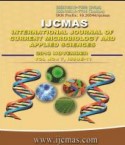


 National Academy of Agricultural Sciences (NAAS)
National Academy of Agricultural Sciences (NAAS)

|
PRINT ISSN : 2319-7692
Online ISSN : 2319-7706 Issues : 12 per year Publisher : Excellent Publishers Email : editorijcmas@gmail.com / submit@ijcmas.com Editor-in-chief: Dr.M.Prakash Index Copernicus ICV 2018: 95.39 NAAS RATING 2020: 5.38 |
The residual effect on soil properties on application of composts made out of composting enzyme industrial wastes and municipal solid wastes namely MEES compost (multiple effect evaporator salts + municipal solid waste) and primary sludge (PS) compost (Primary sludge + municipal solid waste) were evaluated in this study. Application of composts recorded a marginal increase in soil pH towards harvest (6.70 and 6.68 in treatment T8 (50% N through MEES + 50 % N through FYM and T7 (PS compost @ 10 t ha-1) respectively) in comparison to the initial pH and a higher organic carbon content of 0.56 and 0.57 per cent at 30 DAS and 0.52 and 0.53 in T6 (MEES Compost @10 t ha-1) and T7 (PS Compost @ 10 t ha-1) respectively after the harvest of cowpea which was grown as the residual crop. A positive residual effect was evident in compost treatments with an increased status of available major and micro nutrients.
 |
 |
 |
 |
 |